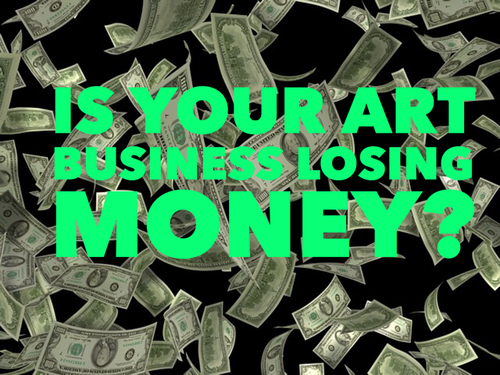by Carolyn Edlund
If you’re not profitable in your business as an artist, you might have one of these problems.

You don’t understand your customer.
Who is the perfect collector for your art, and why should they buy from you? Many artists don’t have clarity on this, and as a result, sales are lacking. When you know your target customer profile, you can create marketing messages that resonate with them. Then, reach out over and over to cultivate their business. And, if you make art that fits into a niche market, it’s easier to know who your customers are and where to find them.
You haven’t priced correctly.
Do you clearly understand how to price your work? Artists frequently find this topic challenging. They may underprice their work out of fear of rejection, or because they are trying to beat out the competition by discounting. Or, they may not understand where their work fits in the marketplace, and how to price given that knowledge. If you are simply guessing at prices without having a real idea of what you need to earn to make a profit, and what the market will bear for your work, this could be a major reason why your business isn’t making money. Knowing how to set your baseline, when to increase prices, and how to add value for a higher perceived price is essential to maximize your income.
You’re not leveraging your art.
Making and selling only original art is the least efficient way to sell. What if you could create art and sell it over and over again? This is the definition of “leveraging” and can help to multiply your earnings or form a passive stream of income. There are a number of ways to do this. You could create a collection that is made in production in your studio, and then sell that merchandise retail to the public, or in the wholesale marketplace. If you don’t want to do the production work, you can use outside vendors or manufacturers – fine art printers are an example of this, making reproductions that can be sold by artists. Alternatively, you could license your art to manufacturers, or license to print on demand providers who can place your images on a variety of items that increase your product offering and price point spread.
You aren’t focusing on your “highest level” activity.
The most important work you do is creating art. As a business person, you also have to do administrative work, marketing, and selling. But, you don’t have to struggle to learn HTML to develop your website, or spend time on extensive bookkeeping if you’re not good at it. Outsource those tasks by hiring a webmaster or accountant to get them done. Hire an assistant to pack and ship, sand or finish product, or perform other tasks that are “below your pay grade.” Find a virtual assistant who can handle social media and other jobs that aren’t your expertise. The more time you can devote to doing what only you can do, the more you will earn, and the less stressed out you will feel.
Your marketing is ineffective.
In order to make sales, you have to engage in marketing. That might involve inviting people to your next open studio event or art festival. It could be online advertising, email marketing or posting on social media to drive traffic to your website. Marketing takes many forms, but the important thing is to be consistent with your message, and persistent with your efforts. Put together a marketing calendar to get organized and stay on track.

Speak Your Mind